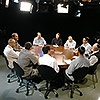Question: In ancient times, our ancestors gathered around the campfire to discuss conflicts, resolve serious issues, and simply to strengthen social bonds.
More than 2,000 years ago, during the Sanhedrin, the sages continued to solve state-level issues in a circle.
In the 5th – 6th century according to legend, the leader of the Britons, King Arthur, also used a round table to make the knights who gathered at it feel equal.
In the modern sense, “round table” has been used since the 20th century as the name of one of the ways to organize the discussion of certain issues.
What is the main purpose of using round tables?
Answer: The main goal of the round tables is to show that all participants are equal; each of them has their own opinion, which they can freely express.
Question: In which cases can a round table be used to resolve state-level conflicts, and in which cases can it simply be used to strengthen bonds?
Answer: If there are serious prerequisites, it is possible to organize round tables at the state level.
However, in the political environment it is very rare to gather people who feel equal corresponding to the concept of a round table. This is usually done to show that everyone seemingly aims for the same thing, although this is almost impossible between politicians.
Remark: When working in a circle, a special effect is formed that allows us to say that the circle is larger than the sum of its participants. This effect can be compared with such concepts as “wisdom of the crowd” and “collective intelligence.”
My Comment: The fact is that here the sum of effort is more than just the sum of the components. Since the participants who make up the round table must rise above their egoism, humble themselves in some way, and agree with the opinions of others, their joint efforts add up and sum up.
It turns out that the round table effect is not just an arithmetic addition, but much more. If the participants’ contradictions were very serious, then if they want to rise above them and reach the “round table” state, they achieve a major effect of connection, communication, and integration.
[270293]
From KabTV’s “Management Skills” 7/9/20
[270293]
From KabTV’s “Management Skills” 7/9/20


No comments:
Post a Comment